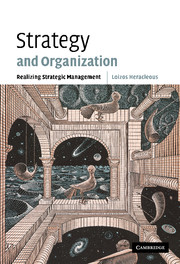Book contents
- Frontmatter
- Contents
- List of figures
- List of tables
- Preface
- I Bases of strategic management
- II Realizing strategy
- III Current themes and applications
- 9 State ownership, privatization, and performance
- 10 Does corporate governance make a difference to organizational performance?
- 11 Types of inter-organizational networks and the strategic roles of directors
- 12 Organizing for the future
- Index of names
- Index of subjects
- References
10 - Does corporate governance make a difference to organizational performance?
Published online by Cambridge University Press: 11 May 2010
- Frontmatter
- Contents
- List of figures
- List of tables
- Preface
- I Bases of strategic management
- II Realizing strategy
- III Current themes and applications
- 9 State ownership, privatization, and performance
- 10 Does corporate governance make a difference to organizational performance?
- 11 Types of inter-organizational networks and the strategic roles of directors
- 12 Organizing for the future
- Index of names
- Index of subjects
- References
Summary
Research on the importance of generally accepted “best practices” in corporate governance has generally failed to find convincing connections between these practices and organizational performance. This chapter discusses research outcomes on the relationship between two such “best practices” (CEO/Chair duality and insider/outsider composition) and organizational performance, that find this relationship to be insignificant. We propose four possibilities for this tenuous relationship, that are not mutually exclusive: first, the possibility that “best practices” in governance are indeed irrelevant to organizational performance; secondly, that the operationalization of theoretical concepts has low face validity; thirdly, that studies are too narrow, aiming to relate board attributes directly to organizational performance and ignoring other systemic factors; and fourthly, the possibility that different types of organizations require different practices in corporate governance. The methodological and substantive implications of each of these possibilities are then addressed.
This chapter suggests, inter alia, that in order to gain an understanding of the strategic role and impact of boards, studies of structural board factors are insufficient; we must rather use in-depth qualitative methodologies to explore actual board functioning, and track the board's role in specific strategic decisions and actions. This shares the methodological perspective of the organizational action (OA) view, its focus on strategic choices by the dominant coalition, and the importance of following through the decisions' impact on realized strategy and performance.
- Type
- Chapter
- Information
- Strategy and OrganizationRealizing Strategic Management, pp. 168 - 183Publisher: Cambridge University PressPrint publication year: 2003



